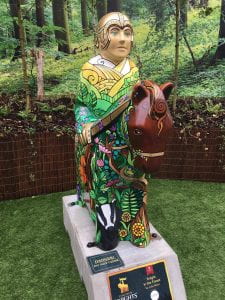This weekend, Lincoln Knights’ Trail opened in celebration of the 800th anniversary of the Battle of Lincoln and the sealing of the Charter of the Forest.
There are 36 sculptures in total placed across Lincoln City Centre and each Knight has been designed and painted by a different artist. (To find out more about the Knights’ trail artists, please click here.)
I did not know anything about the Battle of Lincoln prior to this event, but the Knights’ Trail website has provided a short breakdown of the major events surrounding this period of Lincoln’s history:

‘After agreeing the Magna Carta in 1215, King John went back on his promise which led the country to fall into a civil war. This divided the barons between supporting the crown and rebel barons who invited Prince Louis, the son of the French King, to take the English throne.
In October 1216, King John died and his son, Henry III, was only a child so William Marshal, a famous medieval knight and the King’s champion, acted as regent. By May 1217, much of the country had been taken by the combined French and rebel English forces, but Lincoln Castle held out for the royalist cause under the command of a formidable lady constable, Nicola de la Haye.

On the morning of 20 May 1217, the Royalist army set out from Stowe or Torksey (the sources disagree) to help Nicola and raise the siege. The Royalists broke into the city and in the fighting that followed between the castle’s East Gate and Lincoln Cathedral, the siege of the Castle was lifted and the French commander was killed. The rebels then either surrendered or fled down the hill and towards London. The Royalists claimed victory and then sacked the city. One chronicler ironically nicknamed the battle the ‘Nine-day’ of Lincoln (a Nine-day was either a fair or a tournament) as a battle in the city in 1141 had already been given the title of The Battle of Lincoln.
This battle was of national significance. If the Royalists had lost, England would have become part of France and our King Louis VIII, instead the Plantagenet dynasty ruled for another 250 years.
The 1217 battle and the subsequent defeat of a French naval force at the Battle of Sandwich in August meant Louis’ attempt to become King of England was over. On the 6th of November 1217 Marshal, in the name of the young Henry, reissued Magna Carta in an attempt to reunite the country and with it a companion document called the Charter of the Forest. In contrast to Magna Carta, which mainly dealt with the rights of barons, it confirmed rights of access to royal forests for all men and was not superseded until 1971.’ (Credit: Dr Erik Grigg, Lincoln Knights’ Trail Website)
Both the 1215 Magna Carta and the 1217 Charter of the Forest can still be viewed in Lincoln Castle and the Knights’ Trail sculptures will remain in position until 3rd September 2017.
I am looking forward to seeing all of the Knights’ Trail now that the weather is getting warmer!
